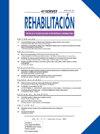Beneficios de un programa de rehabilitación pulmonar para pacientes con COVID persistente: impacto de la gravedad inicial, tiempo de evolución y forma de presentación en los resultados clínicos
IF 0.4
Q3 Medicine
引用次数: 0
Abstract
Introduction
Two-thirds of patients infected with SARS-CoV-2 experience persistent symptoms after infection.
Objectives
To study the benefits of a respiratory rehabilitation program (RRP) in patients with long COVID and compare the results based on the time of evolution and clinical presentation.
Methods
Post-hoc analysis of a prospective cohort of patients with long COVID. Changes were evaluated using the modified Medical Research Council (mMRC) dyspnea scale, the 6-minute walk test (6MWT), maximal inspiratory and expiratory pressures (maxIP and maxEP), and peripheral muscle strength. Statistical tests used: Chi-square, paired and independent t-Student tests, one-way ANOVA, and a general linear model.
Results
Out of 158 patients referred to rehabilitation, 110 (mean age 58.1 years; 57.3% women) started the RRP. After the intervention, significant improvements were observed: a reduction of 0.8 points (95% CI: −1.1 to −0.6) on the mMRC dyspnea scale, an increase of 19.6 m (95% CI: −0.8 to 39.9) in the 6MWT, 16.8 cmH2O (95% CI: 10.3 to 23.2) in maxIP, 22.5 cmH2O (95% CI: 15.3 to 29.7) in maxEP, and 5.0 kg (95% CI: 3.3 to 6.7) in quadriceps strength. Although these improvements were independent of infection onset and disease duration, patients from the first wave showed more modest improvements.
Conclusions
The RRP provides clinical and functional benefits for patients with long COVID, regardless of disease duration and initial severity of infection.
持续的2019冠状病毒病患者肺康复计划的益处:初始严重程度的影响、发展时间和临床结果的呈现方式
三分之二的SARS-CoV-2感染患者在感染后出现持续症状。目的研究呼吸康复方案(RRP)对长COVID患者的益处,并根据病程和临床表现对效果进行比较。方法对长冠状病毒肺炎患者前瞻性队列进行事后分析。使用改良的医学研究委员会(mMRC)呼吸困难量表、6分钟步行测试(6MWT)、最大吸气和呼气压力(maxIP和maxEP)和外周肌力来评估变化。使用的统计检验:卡方检验、配对和独立t-Student检验、单向方差分析和一般线性模型。结果158例康复患者中,110例(平均年龄58.1岁;57.3%的女性)开始了RRP。干预后,观察到显著改善:mMRC呼吸困难量表降低0.8点(95% CI:−1.1至−0.6),6MWT增加19.6 m (95% CI:−0.8至39.9),maxIP增加16.8 cmH2O (95% CI: 10.3至23.2),maxEP增加22.5 cmH2O (95% CI: 15.3至29.7),股头肌力量增加5.0 kg (95% CI: 3.3至6.7)。虽然这些改善与感染的发生和疾病持续时间无关,但第一波患者表现出更温和的改善。结论无论病程和初始感染严重程度如何,RRP均可为长COVID患者提供临床和功能益处。
本文章由计算机程序翻译,如有差异,请以英文原文为准。
求助全文
约1分钟内获得全文
求助全文
来源期刊

Rehabilitacion
Medicine-Rehabilitation
CiteScore
0.80
自引率
0.00%
发文量
63
期刊介绍:
La revista que es desde hace más de 40 años la publicación oficial de la Sociedad Española de Rehabilitación y referente de la mayoría de las Sociedades de la Especialidad de los países americanos de habla hispana. Se publican 5 números pluritemáticos al año y uno monográfico sobre un tema del mayor interés y actualidad designado por el consejo de redacción.
 求助内容:
求助内容: 应助结果提醒方式:
应助结果提醒方式:


